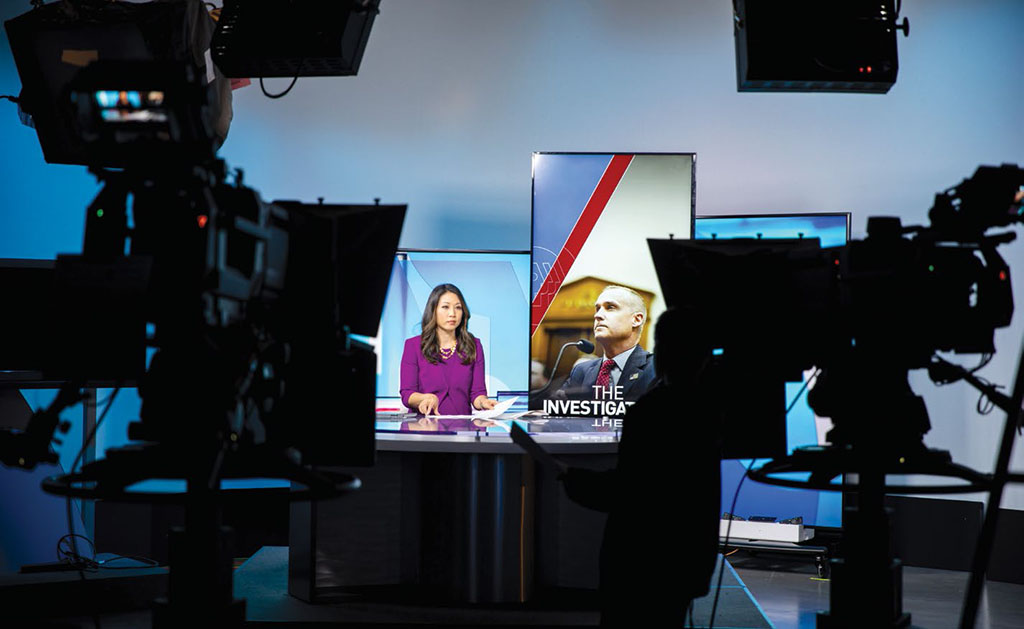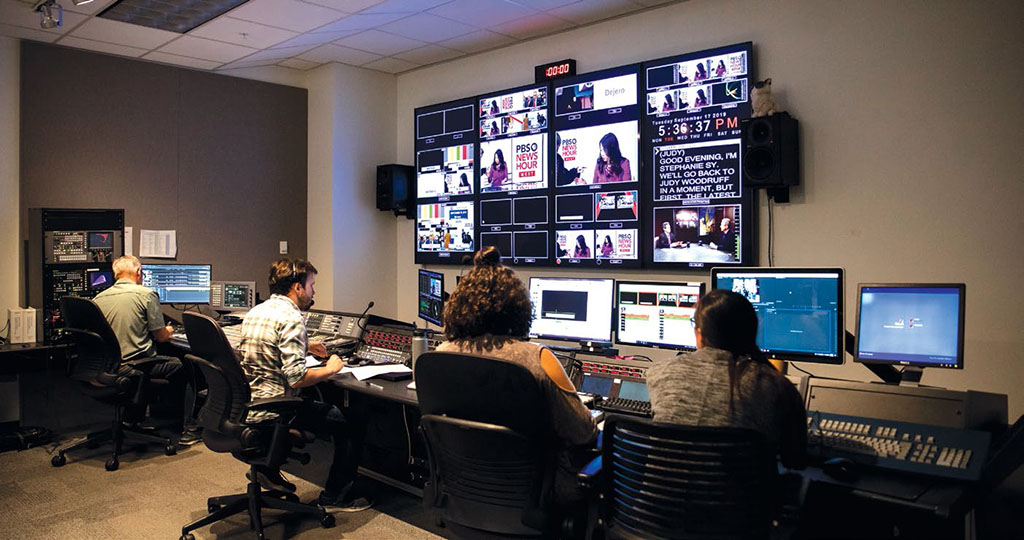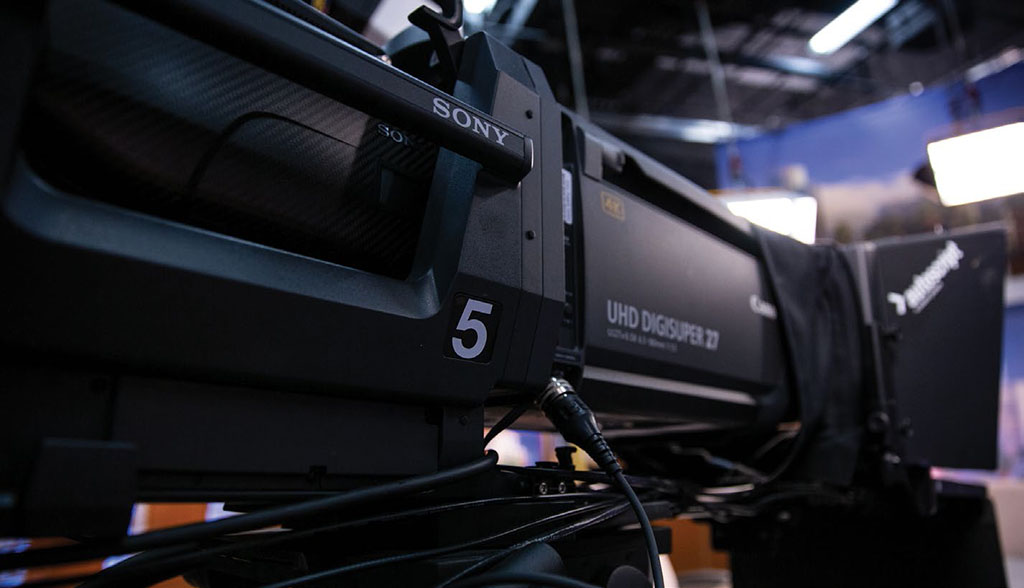Cronkite School Launches PBS NewsHour West

PHOENIX—Students seeking a degree in journalism will likely apply to one of the top schools in the discipline, and the Walter Cronkite School of Journalism and Mass Communication at Arizona State University is one such school. The Cronkite School is the largest media outlet operated by a journalism school in the world, and its more than 2,000 students regularly lead the country in national competitions.
On Oct. 14, 2019, PBS NewsHour West, the new bureau of the “PBS NewsHour,” produced its first broadcast from the Cronkite School. In addition to producing news stories based in the western U.S., the Phoenix-based team updates “PBS NewsHour’s” 6 p.m. ET broadcast for West Coast audiences.
“We are excited to be partnering with the Cronkite School,” said Richard Coolidge, senior producer of PBS NewsHour West. “We currently share the studio and cameras with ‘Arizona Horizon,’ the daily Arizona PBS news program.”
During the past year, students in Cronkite News, the student-staffed, faculty-led news division of Arizona PBS, have produced in-depth packages for broadcast on the “PBS NewsHour.”
A LOT OF COMPETITION
Walter Cronkite once said, “I think it is absolutely essential in a democracy to have competition in the media, a lot of competition, and we seem to be moving away from that.” As the associate dean of the Cronkite School, Mark Lodato leads undergraduate recruitment and retention efforts and supervises the school’s broadcast and sports curriculum. There is also a lot of competition among journalism schools to attract the best and brightest students.
“The relationship with ‘PBS NewsHour’ adds a new level of credibility in the marketplace that I think resonates with prospective students and their families,” Lodato said. “It’s important in today’s climate to have a visual representation of dedication to journalism and the core values of journalism, and that speaks directly to what ‘PBS NewsHour’ is and what we want to do at our school. It’s a nice fit for us, and one that helps us in multiple directions with different stakeholders.”
Get the TV Tech Newsletter
The professional video industry's #1 source for news, trends and product and tech information. Sign up below.
An environment and curriculum like the Cronkite School attracts the attention of professional broadcast executives looking to recruit students. Lodato is also the associate general manager for innovation and design of Arizona PBS, which has been broadcasting from the Cronkite School for more than 10 years.
In 2010, Arizona PBS launched “Cronkite News” daily, giving it the biggest reach of any university-based newscast in the world.
“Recently, we had a high-level NBC News network executive visiting, talking about new opportunities,” Lodato said. “Networks like ESPN and Fox News are regular visitors, as well as CNN.”
Recruiters from national media companies owning several local TV stations are also lining up to hire students as they graduate. “Companies like Tegna and Scripps and Sinclair and Nexstar, they all come through the Cronkite School at a regular clip,” Lodato said.
“What I love is that we’ve grown our curriculum over time so that students, under tremendous faculty supervision and interacting with professionals, are able to engage at a very high level in these various productions,” he added.
PROFESSIONALLY EQUIPPED
Lodato’s role includes the design and implementation of the broadcast studios used on the curricular side. “My goal is to help look for opportunities to bring these different pieces of our worlds together in a way that advances both the student experience and the end-user experience,” he said.
The Cronkite School has three professional control rooms and four fully equipped studios. “We have a lot of resources both for professional as well as student production and training,” Lodato said. “When we moved into this space in 2008 [we wanted] to ensure that we were thinking toward the future and wanted to be able to jump on opportunities for new partnerships like this one with PBS NewsHour, and equipment is a key piece of that.”

As part of the “news teaching hospital” design at the Cronkite School, students have a hands-on opportunity to work with broadcast equipment on daily newscasts, special events, and in key roles for the PBS NewsHour West production.
“After going through classes that provide training and academic credits, they can move on to paid positions as part of the Arizona PBS studio and control room crews,” said Ian MacSpadden, CTO, Arizona PBS, director of broadcast engineering and operations at the Cronkite School.
Cronkite students learn the broadcast business on the latest studio, control room, and newsroom systems available, making the transition from school to the real world a seamless transition, and also benefiting employers. All Cronkite and Arizona PBS control rooms have the same equipment compliment.
“The control rooms are centered on Sony MVS 8000-G production switchers, and supported by Sony BRAVIA 4K multiviewer monitors, ChyronHego Mosaic character generators, and EVS XT3 video playback systems,” MacSpadden said. “All are top-of-the-line systems you will find in many OB trucks and network control rooms.”
The studios have two sets of cameras. For training, Sony 1500 cameras with Fujinon 22x box lenses are used. The larger studios are outfitted with Sony’s new 4K/UHD 2/3-inch HDC-4300 cameras with Canon 27x box lenses, which ride upon Vinten Quattro studio pedestals, with Vinten heads and Autoscript IP prompters.

“In many cases, the stations the graduates will go to will not have this level of quality in their production systems,” MacSpadden said. “Many stations rely heavily on automation, so students who learn at Cronkite actually get to learn about each component in automation systems individually.”
INNOVATING WITH AR
It’s not unusual for Cronkite staff to be told by production equipment vendors and peers from other colleges that they have never seen such an impressive setup.
“That isn’t an accident,” MacSpadden said. “Cronkite is always innovating, so we try to stay ahead of all of the latest industry practices and trends.”
This year the team has begun to implement augmented reality into its weather segments and topical stories.
“We were just selected through a Google program to receive funding to develop an ‘Interactive Story Wall’ that will be used by Cronkite News broadcasters as a tool to tell data-driven stories through visualizations,” MacSpadden said.
For the fifth straight year, U.S. News & World Report recently ranked Arizona State number one on its “Most Innovative Schools” list, ahead of MIT and Stanford.
“Innovation is as common as sunscreen here,” MacSpadden said.
With more than 10 years since the Cronkite School moved into its state-of-the-art journalism education complex in downtown Phoenix, Lodato is reflective.
“What really strikes me is how our growth aligns with the mission of Arizona State University in that we want to be socially embedded, and that means taking responsibility for contributing to our community,” he said. In this case, that’s providing quality news and information and a wonderful education. “This partnership with PBS NewsHour is the latest manifestation of that, and it’s really a unique place to be and a unique place to work, and a unique place to learn. We’re just all very proud of what we’ve been able to accomplish, and excited to see what’s next around the corner.”
